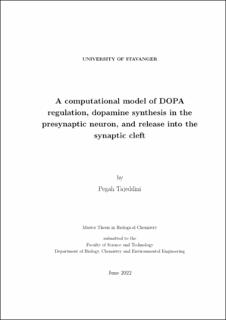| dc.contributor.advisor | Ruoff Peter | |
| dc.contributor.author | Tajeddini Pegah | |
| dc.date.accessioned | 2022-09-08T15:51:18Z | |
| dc.date.available | 2022-09-08T15:51:18Z | |
| dc.date.issued | 2022 | |
| dc.identifier | no.uis:inspera:108217034:69336222 | |
| dc.identifier.uri | https://hdl.handle.net/11250/3016689 | |
| dc.description.abstract | Background: Neurotransmitters and the way neurons communicate with each other have received a lot of attention in recent decades. Dopamine is one of the most important neurotransmitters. Unbalanced levels of dopamine can be associated with physical and psychological disorders like Parkinson’s disease, schizophrenia and addiction[1]. This study shows different regulations performing in the presynaptic neuron to maintain bal- anced DA levels and DOPA as its precursor.
Methods: Fortran subroutine LSODE were used to solve rate equations and model the assumed controlling system to find the relationship between molecules and enzymes contributing in this system.
Results:This study shows that in the presence of different perturbation or even treat- ments, DOPA is the controlled variable and dopamine as controlling variable try to help DOPA maintain in homeostasis. In the studying of dopamine release into the synaptic cleft, the calculation suggested hysteretic behaviour.
Conclusion:There should be a meaningful relationship between varied levels of dopamine and steady state conditions of DOPA in presence of different perturbation and var- ied amount of enzymes. The controller system should help homeostasis of DOPA and dopamine in presynaptic neurons, and robust response to significant signals like action potential. | |
| dc.description.abstract | | |
| dc.language | eng | |
| dc.publisher | uis | |
| dc.title | A computational model of DOPA regulation, dopamine synthesis in the presynaptic neuron, and release into the synaptic cleft | |
| dc.type | Master thesis | |
